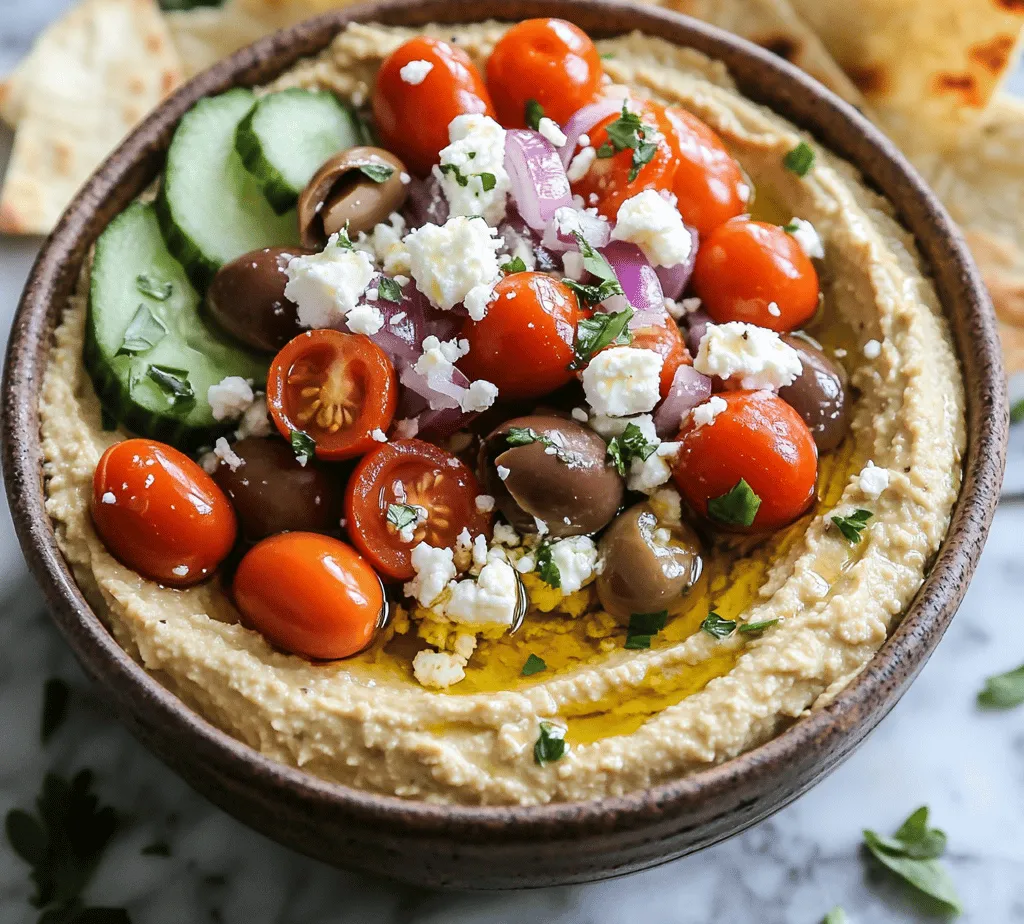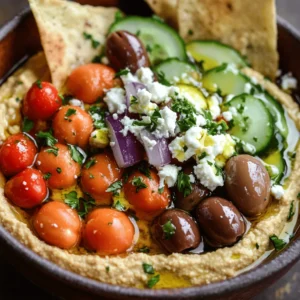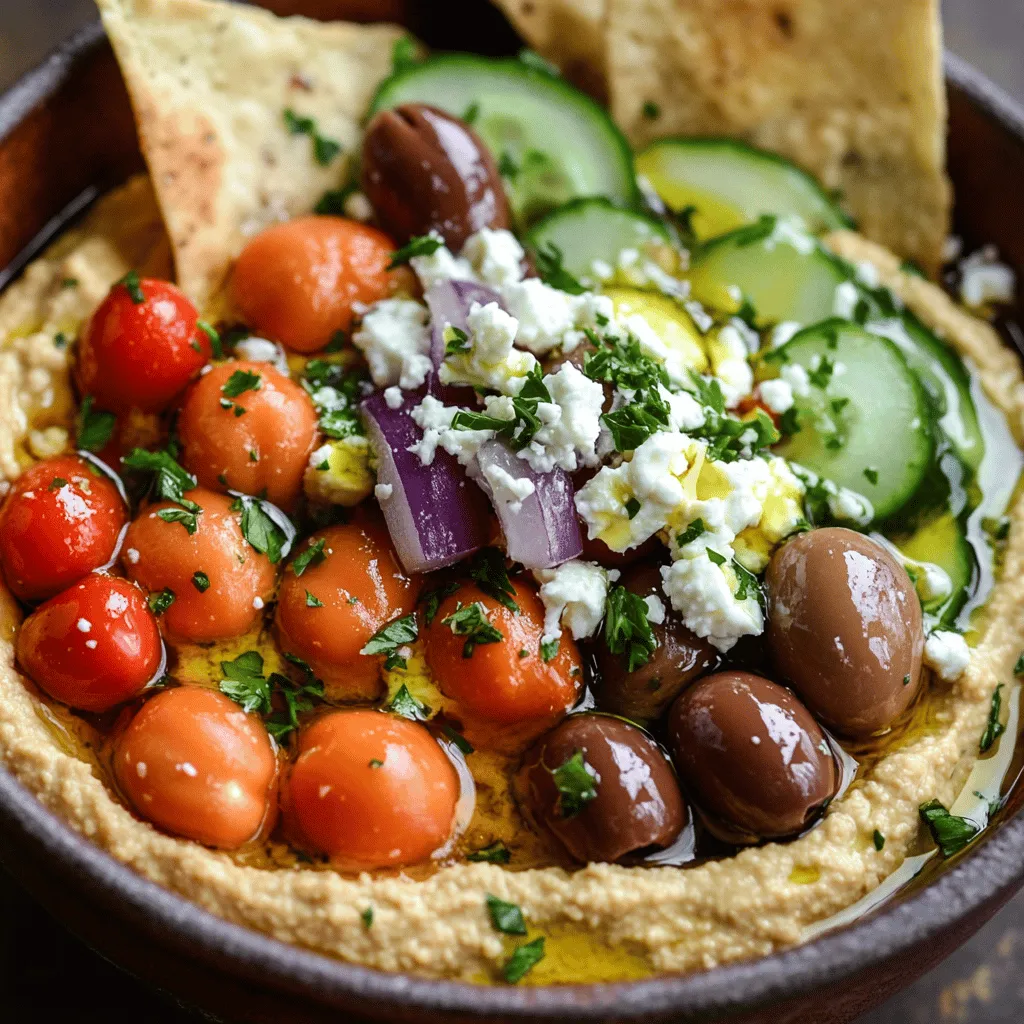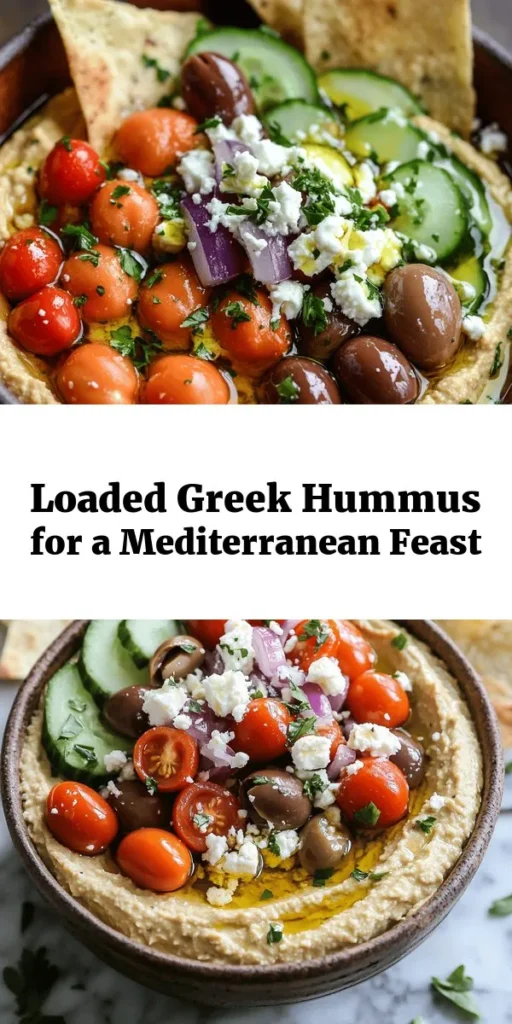Introduction
Mediterranean cuisine captivates the senses with its vibrant flavors, fresh ingredients, and healthful benefits. Renowned for its emphasis on vegetables, whole grains, and healthy fats, this culinary tradition is not only a treat for the palate but also a boon for well-being. One of the standout staples of this cuisine is hummus, a creamy dip made primarily from chickpeas that has garnered worldwide acclaim.
Hummus has become a beloved staple in Mediterranean diets, celebrated for its rich taste and nutritional profile. Its versatility allows it to be enjoyed as a dip, spread, or even a salad base, making it a favorite across various culinary contexts. This article introduces you to a unique twist on the classic dish—Greek-style loaded hummus. This version elevates traditional hummus by incorporating a medley of toppings, including fresh vegetables, briny olives, and creamy feta cheese, creating a dish that’s not only delicious but visually appealing as well.
One of the best aspects of this Greek-style loaded hummus recipe is its simplicity. With minimal preparation and a few key ingredients, you can whip up a delectable dish that impresses guests and satisfies your cravings without spending hours in the kitchen. Whether you’re hosting a gathering, preparing a meal for the family, or looking for a nutritious snack, this recipe promises to deliver Mediterranean bliss in every bite.
Understanding Hummus
Definition and History of Hummus
Hummus, derived from the Arabic word for chickpeas, has a rich history that dates back thousands of years. Its origins can be traced back to the Middle East, where it was first consumed as a nutritious food source by ancient civilizations. The basic recipe includes pureed chickpeas, tahini (a paste made from ground sesame seeds), lemon juice, and garlic. Over the years, hummus has evolved, with various regions adding their own unique spins, resulting in an array of flavors and textures.
The spread has gained immense popularity worldwide, making its way into kitchens and restaurants, far beyond its Mediterranean roots. Today, you can find numerous variations, ranging from roasted red pepper to spicy harissa-infused versions. Despite these adaptations, the fundamental elements of hummus remain the same, showcasing the simplicity and versatility of this beloved dish.
Nutritional Benefits of Chickpeas and Tahini
Hummus is not just a delicious dip; it’s also packed with nutritional benefits that align perfectly with the health-conscious Mediterranean diet. At its core, chickpeas are the star ingredient, renowned for their high protein and fiber content. This legume contributes to satiety, making hummus an excellent choice for those looking to manage their weight. Additionally, chickpeas are rich in essential vitamins and minerals, including folate, iron, and magnesium, which play a vital role in maintaining overall health.
Tahini, another key component, is made from ground sesame seeds and provides healthy fats, particularly monounsaturated and polyunsaturated fats. These fats are known to support heart health by helping to lower bad cholesterol levels. Furthermore, tahini is a source of antioxidants and essential nutrients, such as calcium and iron, making it a powerful addition to this already nutrient-dense dish.
The Role of Hummus in Mediterranean Diets
Hummus holds a special place in Mediterranean diets, often served as a dip or spread alongside pita bread, fresh vegetables, or as part of a meze platter. Its ingredients align perfectly with the principles of the Mediterranean diet, which emphasizes whole foods, healthy fats, and plant-based ingredients. The inclusion of hummus in meals encourages the consumption of more vegetables, legumes, and whole grains, all of which contribute to a balanced and nutritious diet.
Beyond its health benefits, hummus is also a symbol of sharing and community in Mediterranean culture. It is often enjoyed in social settings, bringing people together to savor good food and company. The act of dipping and sharing creates a sense of connection, making hummus not just a meal but an experience.
Ingredients Breakdown
Overview of the Main Ingredients and Their Purpose in the Recipe
Creating the perfect Greek-style loaded hummus requires a careful selection of ingredients to achieve a harmonious blend of flavors and textures. Each component plays a vital role in enhancing the overall dish, from the creamy base to the vibrant toppings. Below is a breakdown of the primary ingredients and what they contribute to the recipe.
Chickpeas: The Star Ingredient and Its Health Benefits
Chickpeas, or garbanzo beans, are the foundation of hummus. Their naturally nutty flavor and creamy texture create the ideal base for this dish. In addition to their culinary benefits, chickpeas are a nutritional powerhouse, rich in protein, fiber, and essential nutrients. They promote digestive health, support heart function, and help manage blood sugar levels, making hummus a wholesome choice for any meal.
Tahini: Importance in Flavor and Texture
Tahini is an essential ingredient that gives hummus its signature creaminess and depth of flavor. This paste, made from ground sesame seeds, not only adds a rich, nutty taste but also contributes healthy fats to the dish. The combination of chickpeas and tahini creates a smooth, velvety texture that elevates the overall experience of eating hummus.
Fresh Garlic and Lemon Juice: Enhancing Flavor Profiles
Fresh garlic and lemon juice are integral to achieving the vibrant flavor profile of Greek-style loaded hummus. Garlic adds a pungent and aromatic quality, while lemon juice provides acidity and brightness, balancing the richness of the tahini and chickpeas. Together, these ingredients enhance the overall taste, making the hummus more flavorful and refreshing.
Extra Virgin Olive Oil: A Heart-Healthy Fat
Extra virgin olive oil is a staple in Mediterranean cooking, celebrated for its health benefits and robust flavor. In this hummus recipe, it serves multiple purposes: adding richness, improving texture, and enhancing flavor. The heart-healthy monounsaturated fats in olive oil contribute to cardiovascular health, making it a nutritious addition to your loaded hummus.
Ground Cumin: Adding Warmth and Depth
Ground cumin is a spice that brings warmth and depth to the dish. Its earthy flavor complements the other ingredients and adds complexity to the hummus. Cumin is commonly used in Mediterranean and Middle Eastern cuisine, making it a perfect fit for this recipe.
The Toppings
The toppings are what truly set Greek-style loaded hummus apart, transforming it into a colorful and satisfying dish. Here’s a closer look at the toppings that will elevate your hummus experience:
Fresh Vegetables (Cherry Tomatoes, Cucumber, Red Onion) and Their Textures
Fresh vegetables not only add beautiful color but also provide crunch and freshness, making them essential toppings for loaded hummus. Cherry tomatoes contribute juiciness and sweetness, while cucumbers offer a refreshing crunch. Red onion adds a sharp bite that contrasts beautifully with the creamy hummus. Together, these vegetables create a delightful medley of textures that enhance each bite.
Kalamata Olives: Their Role in Adding Brininess
Kalamata olives are a quintessential element in Greek cuisine, known for their deep flavor and brininess. When added to loaded hummus, they introduce a savory element that balances the creaminess of the hummus and the freshness of the vegetables. Their unique taste is a hallmark of Mediterranean dishes, making them a must-have topping for this recipe.
Feta Cheese: Creaminess and Flavor Enhancement
Feta cheese is another key ingredient that enhances the flavor and texture of Greek-style loaded hummus. Crumbled feta adds a creamy, tangy element that pairs perfectly with the other toppings. Its salty profile complements the brininess of the olives and the sweetness of the tomatoes, creating a harmonious flavor balance.
Fresh Parsley: Aesthetic Appeal and Freshness
Finally, fresh parsley serves as both a garnish and a flavor enhancer. Its bright green color adds visual appeal and freshness to the dish. Parsley also contributes a mild herbal flavor that ties all the elements together, making your loaded hummus not only delicious but also beautiful to present.
Step-by-Step Preparation
Creating Greek-style loaded hummus is a straightforward process that anyone can master, even kitchen novices. Follow these detailed instructions to ensure your hummus turns out perfectly creamy and delicious.
Detailed Instructions for Making the Hummus
1. Prepare the Chickpeas: If using canned chickpeas, drain and rinse them under cold water. For optimal creaminess, consider removing the skins from the chickpeas. While this step is optional, it can significantly improve the texture of your hummus.
2. Blend the Base Ingredients: In a food processor, combine the prepared chickpeas, tahini, minced garlic, fresh lemon juice, and ground cumin. Begin blending on a low speed, gradually increasing to high. Add a pinch of salt to enhance the flavors.
3. Adjust Consistency: While blending, slowly drizzle in the extra virgin olive oil. This will help emulsify the ingredients and create a smooth texture. If the hummus appears too thick, add water, one tablespoon at a time, until you reach your desired consistency. Remember, the goal is a creamy, spreadable dip.
4. Taste and Season: Once blended, taste your hummus and adjust the seasoning as needed. You may wish to add more salt, lemon juice, or garlic to suit your personal preference. Blending thoroughly after each adjustment will allow you to achieve the perfect flavor balance.
5. Serve and Garnish: Transfer the hummus to a serving dish, making a shallow well in the center. Drizzle with additional olive oil and arrange your toppings—cherry tomatoes, cucumber, red onion, Kalamata olives, crumbled feta cheese, and fresh parsley—artfully over the hummus.
Emphasize the Importance of Blending Techniques for Optimal Smoothness
Achieving the perfect texture is crucial in making hummus. To ensure that your hummus is as smooth and creamy as possible, use a high-powered food processor. Blend the ingredients thoroughly and don’t rush the process; allow the machine to run for several minutes. If you find your hummus is still grainy, continue blending while adding small amounts of water or olive oil until you achieve that velvety texture.
Discuss the Role of Adjusting Seasoning and Consistency
The beauty of homemade hummus lies in its adaptability. Different brands of chickpeas, tahini, and even the freshness of your garlic and lemon juice can affect the overall flavor. Hence, it’s important to taste your hummus throughout the process and make adjustments as needed. If you prefer a tangier flavor, add more lemon juice; if you enjoy a stronger garlic presence, increase the garlic content. Adjusting the consistency is equally important; remember to add water or olive oil gradually to avoid making the hummus too runny.
By following these steps and paying attention to the nuances of flavor and texture, you’ll create a Greek-style loaded hummus that not only showcases the best of Mediterranean cuisine but also becomes a staple in your culinary repertoire. Enjoy the process and have fun experimenting with different toppings to make this dish your own.

Creating the Loaded Topping
The crowning glory of your Greek Style Loaded Hummus is undoubtedly the vibrant vegetable topping. This topping not only adds a burst of color but also enhances the flavor profile, making every scoop a delightful experience. Here’s how to mix and prepare the vegetable topping.
How to Mix and Prepare the Vegetable Topping
1. Gather Your Vegetables: Choose a variety of fresh vegetables that will add both crunch and color. Consider using diced bell peppers, cherry tomatoes, red onions, cucumber, and fresh herbs like parsley or mint.
2. Prepare the Vegetables: Start by washing and drying your vegetables thoroughly. Dice the bell peppers and cucumber into small, bite-sized pieces. Halve the cherry tomatoes and finely chop the red onion. Keep the sizes consistent for a harmonious texture.
3. Mixing the Topping: In a medium bowl, combine all the prepared vegetables. Add a generous handful of freshly chopped parsley or mint for an aromatic lift.
4. Seasoning: The significance of seasoning cannot be overlooked. Add a pinch of salt and pepper to taste. For an extra layer of flavor, drizzle a tablespoon of fresh lemon juice over the mixture. This will add brightness and enhance the natural flavors of the vegetables.
5. Adding Olive Oil: Drizzle about one to two tablespoons of high-quality extra virgin olive oil over the vegetable mixture. Olive oil is not just a delicious addition but also brings healthy fats that complement the dish beautifully. Toss gently to combine all ingredients, ensuring each piece is well-coated.
Serving Suggestions
Presentation plays a vital role when serving your Greek Style Loaded Hummus. Not only does it make the dish visually appealing, but it also enhances the overall dining experience.
Presentation Ideas for a Visually Appealing Dish
To create a stunning presentation, start by choosing a large, shallow serving bowl for your hummus. Use the back of a spoon to spread the hummus evenly, creating a slight well in the center. This well will hold your vegetable topping beautifully.
Creating an Inviting Serving Platter
Arrange your vegetable topping artfully in the center of the hummus. Consider layering the vegetables for added height and texture. You can also sprinkle some crumbled feta cheese on top for an added touch of flavor and visual appeal. To elevate your serving platter, include small bowls of dippers around the hummus, creating a beautiful and inviting spread.
Best Dippers for Hummus
When it comes to dipping, the options are plentiful. Some of the best accompaniments for your Greek Style Loaded Hummus include:
– Pita Chips: Crunchy and perfect for scooping, pita chips are an excellent choice. You can even toast your own pita bread for a warm, homemade touch.
– Fresh Veggies: Sliced cucumbers, carrots, bell peppers, and celery sticks offer a refreshing crunch and complement the creamy hummus well.
– Warm Pita Bread: Soft, warm pita bread is a classic choice that pairs beautifully with the hummus and topping, allowing for a delightful taste experience.
Pairing Suggestions with Beverages or Additional Dishes
To round out your meal, consider pairing your Greek Style Loaded Hummus with light Mediterranean beverages such as sparkling water infused with lemon or a crisp white wine like Sauvignon Blanc. For a more substantial meal, serve it alongside grilled chicken skewers, a fresh Greek salad, or a quinoa tabbouleh.
Health Benefits of Greek Style Loaded Hummus
This dish is not only delicious but also packed with nutritional benefits. Here’s a breakdown of what makes Greek Style Loaded Hummus a healthy choice.
Nutritional Analysis of the Full Dish
The primary ingredient, chickpeas, is a fantastic source of protein and fiber, which helps keep you satiated longer.
Protein Content from Chickpeas and Feta
Chickpeas provide around 15 grams of protein per cup, making them an excellent plant-based protein source. When you add feta cheese, you introduce additional protein and calcium, both essential for bone health.
Healthy Fats from Olive Oil and Tahini
Olive oil and tahini, both key components in this recipe, are rich in healthy fats. These fats are crucial for heart health and can help lower bad cholesterol levels. One tablespoon of tahini contributes to your daily intake of vitamins and minerals, including calcium and magnesium.
Vitamin and Mineral Contributions from Fresh Vegetables
The fresh vegetables used in the topping are not only colorful but also packed with vitamins. Bell peppers are high in vitamin C, while cucumbers contribute hydration. Tomatoes offer antioxidants, and the herbs provide essential nutrients, enhancing the overall health profile of the dish.
Discussing the Benefits of a Mediterranean Diet on Overall Health
The Mediterranean diet is widely celebrated for its health benefits, including reduced risks of heart disease, improved cognitive function, and better weight management. By incorporating Greek Style Loaded Hummus into your meals, you are embracing a key component of this healthy lifestyle.
Cultural Significance of Hummus in Mediterranean Cuisine
Hummus is more than just a dish; it embodies a rich cultural heritage and plays an essential role in Mediterranean cuisine.
Exploration of Hummus in Various Mediterranean Cultures
Originating in the Middle East, hummus has spread across the Mediterranean, with each region adding its own twist. In Lebanon, for example, hummus is often garnished with pine nuts and served with spiced meats, while in Israel, it may be topped with spicy condiments and served in a pita.
The Tradition of Sharing Hummus in Social Settings
Hummus is a staple at gatherings, symbolizing hospitality and togetherness. It is common for families and friends to share a platter of hummus, encouraging conversation and connection over food.
Connection to Community and Hospitality Through Food
In many Mediterranean cultures, food is a way to bring people together. The act of sharing hummus fosters a sense of community. From family dinners to festive celebrations, hummus is often at the center of social interactions, highlighting its significance as a dish of unity.
Variations and Adaptations
The versatility of hummus allows for countless variations, making it easy to customize based on personal preferences or dietary needs.
Suggestions for Personalizing the Hummus Recipe
Feel free to experiment with different toppings such as roasted red peppers, olives, or even spicy harissa for a kick. You can also blend in different herbs or spices to create a unique flavor profile.
Alternative Ingredients for Dietary Restrictions
For those with dietary restrictions, hummus is easily adaptable. Use gluten-free pita chips or vegetables for dipping. You can also create a vegan version by substituting non-dairy yogurt for feta cheese.
Flavor Variations
For those who enjoy a little heat, consider adding roasted garlic or a pinch of cayenne pepper to the chickpeas during blending. An herb-infused version can be achieved by blending in fresh basil or dill for a refreshing twist.
Conclusion
Preparing and sharing Greek Style Loaded Hummus is a joyful experience that brings together rich flavors, vibrant colors, and a sense of community. The health benefits of this dish, rooted in the principles of the Mediterranean diet, make it a wholesome choice for any occasion.
As you explore Mediterranean cuisine through this simple yet delightful recipe, remember that food is not only sustenance but also a way to connect with others. Whether you’re hosting a gathering or enjoying a quiet evening at home, this loaded hummus will undoubtedly impress and satisfy. So gather your ingredients, invite some friends over, and enjoy the deliciousness that is Greek Style Loaded Hummus.



